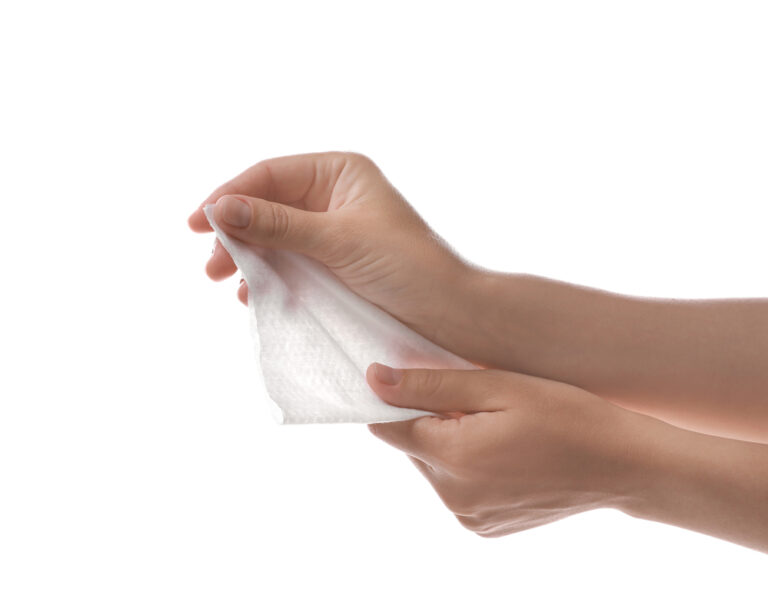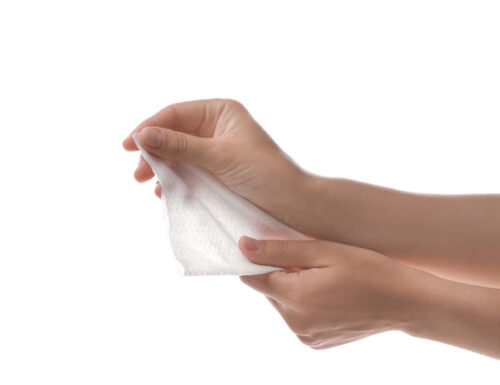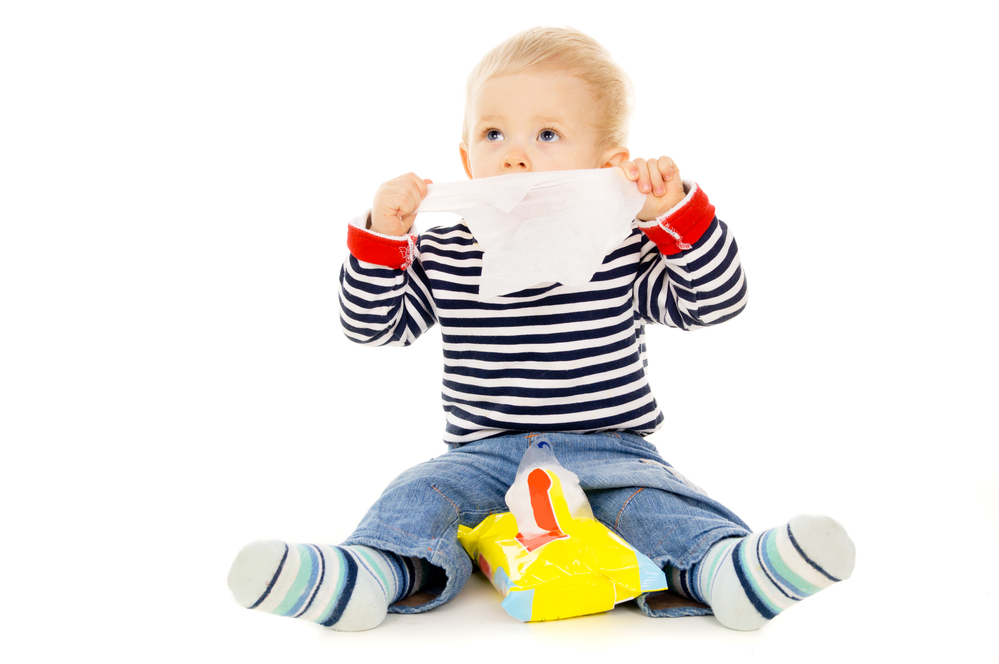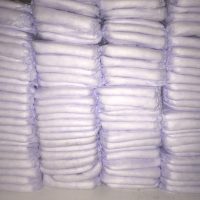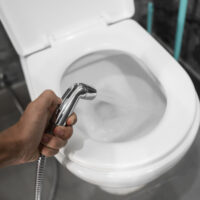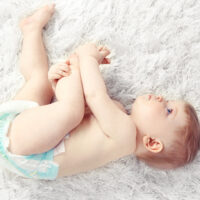Learning how to make baby wipes at home is a great parenting hack.
When it comes to baby supplies and gear, costs can quickly add up. One way to save on baby expenses is by making your own wipes at home.
Not only is it much less expensive, but you get to control what ingredients you are using. Controlling ingredients oftentimes means you are preventing harsh chemicals from coming into contact with your little one.
In addition to these benefits, you are also making great choices for the environment, as DIY wipes are a much greener option than some store-bought choices.
Here are our favorite ways to make your own baby wipes.
Basic Baby Wipe Recipe
There are a number of ways to make your own baby wipes, with the top two choices being reusable, such as cloth or disposable wipes.
Generally, you will follow the same basic recipe regardless of whether you choose cloth or disposable.
- Wipe Material (cloth for reusable, heavy-duty paper towels for disposable)
- Plastic storage container with a lid
- 2 cups of boiled water or warm distilled water
- 2 tablespoons of baby soap or unscented Castille soap
- 1 tablespoon of baby oil, almond oil, or olive oil
- Essential Oils of your choice if you want a scent
It is recommended that you boil your water or use distilled water due to potential bacteria in tap water. Boil water just for a few minutes and then allow to cool slightly. Water should still be warm when you mix in your soap and oil so that they dissolve appropriately.
You’ll want to use a wide-mouth plastic container with a durable lid to store your wipes inside if you go with disposable. Place your paper towels into the container and saturate with the soap solution. Due to the moisture and lack of chemicals, mold can happen if you store your disposable wipes for more than a week at a time. Make sure to clean your container thoroughly before adding in your next batch of DIY baby wipes.
If you choose to make cloth wipes we instead recommend putting your soap solution into a spray/squirt bottle and applying it to your cloth wipes when you are ready for a diaper change. You can easily keep a stack of clean cloth wipes and a small bottle of the solution near your changing station for easy access.
Best Baby Wipe Ingredients for Your Baby
You may choose to use baby soap or Castille soap. Both are great choices and can be tailored specifically to your desires and your baby’s skin type. If you have a baby soap or shampoo that you use at bathtime and you know does not irritate your baby’s skin, that’s all you need!
We recommend adding baby oil, almond oil, or olive oil to help moisturize your baby’s skin and prevent it from drying out. Again, choose your oil based on your preference and your baby’s skin type.
Add a few drops of your favorite essential oils if you want scented wipes, but this is a totally optional part.
DIY Disposable Wipes
Making your own disposable wipes is a great way to still have ease of convenience while having control over costs and ingredients. There are a few different ways to make disposable wipes, with the top recommendation being to use paper towels. You can easily make these wipes in under 10 minutes and for close to just $1 a batch.
Paper Towel Baby Wipes
Heavy-duty paper towels are recommended when making disposable wipes at home so that the wipes are sturdy and will not disintegrate while you are trying to clean your baby. Paper towels make soft and gentle baby wipes that stand up to their store-bought counterparts.
The beauty of these DIY baby wipes is that they are fast and easy to make, super affordable, and contain no harsh chemicals. One roll of paper towels makes 2 batches of wipes, which leaves you spending roughly $1 per set of wipes.
First, gather your materials. Use a serrated knife to cut your paper towel roll in half. You will only need half of the roll at a time, so set the other half aside for when you are ready for a refill. Place the half roll of paper towels into your container and follow the above recipe for your soap solution.
Allow your mixture to cool down, and then evenly pour over the paper towels. Once the paper towels are saturated, wait a few minutes and then pull out the cardboard tube from the center. If it is thoroughly wet it should remove easily.
Place the lid onto your container and voila! When you’re ready to start using your wipes, remove them from the center of the roll. If your wipes start to dry out before you have finished using them, you can refresh them by adding additional boiled water.
When you’re ready for a new set of wipes, grab the other half of your paper towels and start the process all over again.
Make sure to clean and sanitize your plastic container in between sets of wipes to prevent mold growth.
DIY Cloth Baby Wipes
If you’re looking for a great way to reduce, reuse, and recycle, making your own cloth baby wipes is an excellent choice. You can choose to sew the edges to prevent fraying, or just cut into decent-sized squares or rectangles and hit the ground running. If you’re already using cloth diapers then cloth wipes are the next best thing.
Cotton Fabric Baby Wipes
The best fabric to use for cloth baby wipes is flannel or 100% cotton as they will be soft and durable. If you have old receiving blankets at home, these are perfect to repurpose into baby wipes. But really, any fabric will do.
Cut your fabric into roughly 9-inch squares or 9-inch long rectangles. If you choose a no-sew method you can try using pinking shears to prevent some fraying on the edges.
If you have a sewing machine and a little creativity, you can sew the edges or add layers for extra durability and a longer-lasting wipe. Make sure to sew through multiple layers so that your wipes do not balloon and stretch when washed.
Once you have the size you’re happy with, place the cloth wipes close to your changing area. Instead of adding the liquid to a container with cloth wipes, we recommend filling a spray/squirt bottle with the soap solution and saturating a cloth prior to use. This will prevent the fabrics from absorbing all of the liquid and will allow more even distribution.
Grab a wipe as needed, spray with your cleaning solution, and you’re ready for a diaper change! You and your baby will love how soft fabric wipes feel on their bottom.
Washing Your Reusable Baby Wipes
If you’re already using cloth diapers, then you can add your cloth wipes to the same laundry pile. If you’re new to cloth diapering supplies, don’t let cleaning them deter you. You can wash and dry cloth wipes as you would any laundry, but you may choose to wash them in a separate load than your other clothes.
Some families opt to use cloth wipes for pee diapers only, but, if you’re feeling brave, they are great for even the messiest of diapers. We do recommend you rinse wipes from a bowel movement into the toilet before adding them to the laundry pile.
Wash all of your wipes together or with other rags that need to be laundered at the same time. Always wash your cloth wipes on a hot cycle, and you can add a little baking soda to the cycle for a cleaning boost.
If you have soiled cloth wipes or diapers, you can store them in a wet bag prior to laundry day.
Wet bags are great because they can be tossed right into the laundry along with diapers and wipes so that everything comes out clean and ready for the next round. They’re also great if you’re out and about and want to prevent wet diapers or wipes from getting the rest of your diaper bag dirty. Or toss wet swimsuits inside and safely transport them home. We love gear with versatile use!
FAQ’s About DIY Baby Wipes
Why should you make your own wipes?
Some of the top reasons families choose to make their own wipes is because of the budget savings, and the ability to control ingredients.
If your baby has sensitive skin, you may find that certain wipes irritate their skin more than others. By making your own you can control exactly what comes into contact with their skin, and cloth wipes, in particular, are soft and gentle.
It’s also a great feeling knowing that you can make your own wipes at home should supplies be limited at a store, or you’re waiting on the arrival of supplies.
If you’re making cloth wipes, how many should you make?
This depends on how many diapers a day you are changing and how frequently you plan on washing laundry. You will also likely find that cloth wipes are more effective than disposable. Therefore you will need fewer wipes per diaper change.
Before you make the switch to making your own wipes gather an average of how many wipes you are using per day. Now multiply your daily average by how many days you go between laundry loads. Or you can take an average of how many diapers you change per day, add a wipe or two per diaper, and give yourself a couple of day buffer. If you see the laundry piling up, or the stack of wipes getting smaller, then you know it’s time to start laundry!
How long does the soap solution last?
If you have already added your soap solution to a roll of paper towels, we recommend that you use them within one week. Closed plastic containers with moisture can be a breeding ground for mold. Make sure to clean and sanitize your container frequently as you are changing out wipes.
If you have added your soap solution to a bottle to use with cloth wipes, the solution should be perfectly useable for months. Feel free to make a big batch and just give it a good shake before refilling your container.
Can you add isopropyl alcohol to baby wipes?
Alcohol should not be added to baby wipes if you intend to use them on your child.
However, you can add isopropyl alcohol to the soap solution if you would like to turn your baby wipes into a sanitizing wipe. You can take your disposable baby wipes, add alcohol to the container, and sanitize while on the go. However, clearly label your containers so that you do not accidentally use the wrong wipes during a diaper change!
Final Word
It is really easy to learn how to make baby wipes at home. You will quickly see the benefits add up! Does it take a little more work? Yes. But is the payoff worth it? Also yes! Some of the top benefits include cost savings, clean ingredients, and eco-friendly materials.
The fact that you have options for disposable or reusable baby wipes with the same soap solution can be a time saver as well. You can try making cloth wipes for at home, and disposable for on the road or messier diapers. No need to rely on expensive baby supplies when you can easily make your own!
Would you make your own baby wipes? Let us know in the comments!
